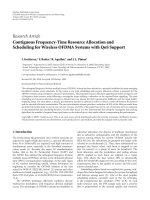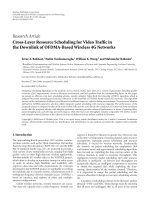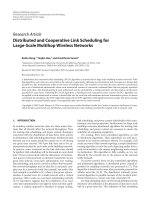AMERICAN SPORTS BUILDERS ASSOCIATION CRITICAL PATH METHOD SCHEDULING FOR SUCCESS
Bạn đang xem bản rút gọn của tài liệu. Xem và tải ngay bản đầy đủ của tài liệu tại đây (961.91 KB, 37 trang )
AMERICAN SPORTS
BUILDERS ASSOCIATION
CRITICAL PATH METHOD
SCHEDULING FOR SUCCESS
December 6-8, 2008
New Orleans, Louisiana
Presented By: Bill Pronevitch
SCHEDULING- Is It Necessary?
• Effective Project Management involves
coordinating activities such as:
–
–
–
–
Planning
Organizing
Controlling Time (scheduling)
Cost
• The “Scheduling” process forces people to:
– Quantify their effort in discrete terms
– Place tasks in proper relationships
SCHEDULING- Methodologies
• Two of the most common methodologies:
– Bar Charts
– Critical Path
• ADM: Arrow Diagramming Method
• PDM: Precedence Diagramming Method
• Both scheduling methods are widely used for:
– Controlling
– Making optimal use of project time
SCHEDULING- Bar Charts
• Bar Charts (also called “Gantt Charts”) are
primarily for controlling Time elements:
– Analyze/ specify the basic approach to be used
– Segment the work into a reasonable number of
activities that can be scheduled
– Estimate the time required to perform each
activity (i.e.- activity duration)
– Place activities in “time-order” (logic)
– Adjust the chart until the specified completion
date, if one exists, is satisfied.
SCHEDULING- Bar Chart
A
Gantt Chart
(Bar Chart) shows:
B
•All Activities and
Status on a Single
Chart
C
D
E
F
0
1
2
3
4
5
6
7
8
9
10
11
12
SCHEDULING- Bar Charts
• Benefits:
– Plan, Schedule, and Progress on a single chart
– A simple, understandable way to schedule small
projects or undertakings
• Disadvantages:
– Activity-limited, can’t handle complex projects
– Doesn’t show logic ties (activity relationships)
– Insufficient detail to enable timely detection of
schedule slippages on long duration activities
SCHEDULING: Critical Path
• The Critical Path Method (CPM) was
designed for and is useful on projects where
the duration of each activity can be
with reasonable certainty
- it predicts project overall completion
- it identifies the (critical) activities that
control the overall length of the project
• CPM is widely used in: process industries
construction and plant outages/ shutdowns.
SCHEDULING: Critical Path
• Benefits:
– Determines shortest project completion time
– Identifies “critical” activities – that can not be
slipped or delayed (i.e.- “TOTAL FLOAT”)
– Shows allowable slippage for “non-critical”
activities (i.e.- “FREE FLOAT”)
• Disadvantages:
– Large number of activities required
– Difficult to read, understand, and maintain.
SCHEDULING: CPM/ADM
• ADM (Arrow Diagramming Method):
– Arrow (line): represents an Activity
– Tail (of arrow): shows an Activity’s start
– Head (of arrow): shows an Activity’s finish
– Node (or event): shown at each end
• The “Activity Number” consists of Head and Tail
numbers, commonly referred to as I-J nodes (i.e.- “IJ Method” of CPM)
SCHEDULING: CPM/ADM
ADM: Arrow Diagramming Method
Process Work
Requisition
Install
Order
Material
Pump
1
4
2
Assign
Crew
3
5
(Dummy Activity – shows
relationship, zero duration)
SCHEDULING: CPM/ADM
• Benefits:
– Allows use of “Dummy Activities” which:
• Have a “ZERO” time duration
• Can be used to show additional relationships
• Disadvantages:
– An Activity’s “Predecessor” must be complete
before the Activity can start!
– Neither the Activity’s “arrow length” or “arrow
direction” have any meaning
SCHEDULING: CPM/PDM
• PDM (Precedence Diagramming Method):
– Box/ Node: represents an Activity
– Line/ Arrow: represents a Precedence – with time
and direction properties
• Precedence consist of two parts:
– “Relationship”: a Predecessor or Successor
– “Lag”: the (positive or negative) number of work
periods by which a specified Activity will be
delayed (assumed to be “0” if not specified)
SCHEDULING: CPM/PDM
PDM: Precedence Diagramming Method
Process
Work
Order
Requisition
Material
Install
Pump
A
B
C
Assign
Crew
D
Pump
Installation
Completed
E
SCHEDULING: CPM/PDM
• Types of Relationships, Lags (aa,n):
– FS, 0: Finish-to-Start, With “0 units” of delay
– FF, 7: Finish-to-Finish, with “7 units” of delay
– SS, 5: Start-to-Start, with “5 units” of delay
– SF, 0: Start-to-Finish, with “0 units” of delay
SCHEDULING – PDM/ LOGIC
Relationships (Logic Ties, Lags
Finish -to- Finish
Finish –to- Start
A
(FS,0)
A
B
B
Start –to- Start
A
(SS,4)
(FF,5)
Start –to- Finish
B
B
A
(SF,0)
SCHEDULING: CPM/PDM
• “6” Major Types of Constraints
– Start On: a mandatory date
– Start No Earlier Than*: can start “later”
– Start No Later Than*: can start “earlier”
– Finish On: a mandatory date
– Finish No Earlier Than*: can finish “later”
– Finish No Later Than*: can finish “earlier”
* NOTE: Schedule logic drives “earlier” and “later”
start and finish dates
SCHEDULING- PDM/ OTHER
• Hammock Activity
– Spans many activities to show an “overall”
performance period (i.e.- a summary activity)
• Logic Loop
– One of the most common “scheduling errors”
– Occurs when a set of activities precede each
other in a “circular” fashion, (a group of activities
can never begin nor end)
– Must be eliminated prior to calculating the
schedule (i.e.- running a time analysis)
SCHEDULING- Hammock
PDM: Hammock (Summary) Activity
A
B
C
D
E
SCHEDULING – PMD/LOOP
LOOP: No beginning or end
(a circular path)
A
B
C
LOOP
F
E
D
SCHEDULING – PDM/ CALC’S
• Once a network has been created and the durations
estimated for each activity, both the “Total Time” to
reach project completion and each activity’s
“individual” start and finish times, can be calculated
– Manual computation is easy and logical (but
tedious & time-consuming on large projects)
• Forward Pass: calculates early start/finish, (ES/EF)
• Backward Pass: calculates late start/finish, (LS/LF)
SCHEDULING – CALC’S
• FORWARD PASS:
– Calculates “Earliest Start” and “Earliest Finish”
times, observing the following rules:
• Assign an “ES” time to the first activity
• Other activities start as soon as their
“predecessor” relationships have been satisfied
• Equations:
– ES = EF (Pred.) + 1
– EF = ES + Duration - 1
SCHEDULING – CALC’S
• BACKWARD PASS:
– Calculates “Latest Start” and “Latest Finish”
times, observing the following rules:
• Assign an “EF” time to the last activity.
• All activities finish as soon as their “Successor”
relationships have been satisfied.
• Equations:
– LF = LS (Succ.) – 1
– LS = LF – Duration + 1
SCHEDULING – CALC’S
• PDM ACTIVITY NOTATION:
–
–
–
–
Activity Number: unique number to an activity
Duration: number of “work periods” assigned
ES & EF: calculated in Forward Pass
LS & LF: calculated in Backward Pass
ACTIVITY NUMBER
ES
LS LF
EF
1
A
5
3
5
7
DURATION
FORWARD & BACKWARD PASS
10
40
5
14
20
START
4
50
4
60
5
30
5
Legend
FINISH
Activity ID
ES
LS
EF
Duration
LF
FORWARD & BACKWARD PASS
10
40
1
5
5
6
14
19
20
6
START
9
10
4
5
5
13
9
20
5
24
24
Legend
ESs = EFp + 1
EFs = ESs + Ds - 1
60
30
Early Dates:
4
50
FINISH
Activity ID
ES
LS
EF
Duration
LF









